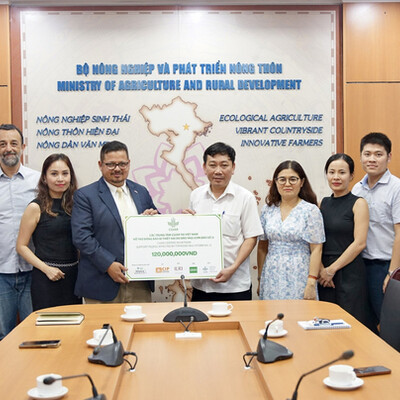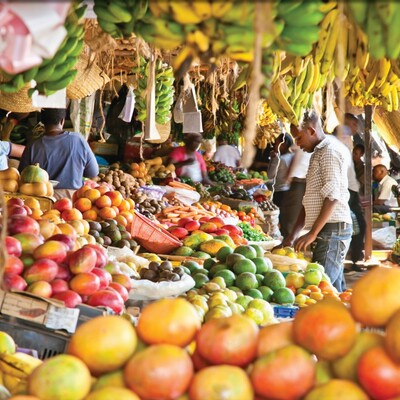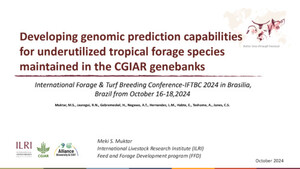
Tracking the livestock sector for better climate change adaptation and mitigation in Kenya
Globally, countries are making pledges to reduce their greenhouse gas (GHG) emissions as part of the Paris Agreement, and Kenya is among those that have submitted an updated Nationally Determined Contribution (NDC). The country has set a target of reducing GHG emissions by 32% below a business-as-usual scenario by 2030 and has also committed to enhancing climate change adaptation. Many sectors will play a role in meeting these targets, including energy, forestry, transport and agriculture. Within agriculture, the NDC specifically mentions climate-smart agriculture (CSA), focusing on efficient livestock management systems to reach both adaptation and mitigation targets.
How can the livestock subsector focus on increasing overall productivity and efficiency and help Kenya meet its climate change goals? On Wednesday, 21 April, an online stakeholders meeting discussed the priorities and gaps for livestock production systems to contribute to the targets set.
Bernard Kimoro of the State Department of Livestock and the Climate Change Unit of the Ministry of Agriculture, Livestock, Fisheries and Cooperatives introduced a recent report detailing findings on how actions within different subsectors such as dairy, beef, small ruminants and poultry can help producers improve production while also reducing the intensity of emissions from the respective systems.
The dairy subsector is often the focus of conversations around livestock and climate change in Kenya because of the well-known ways that dairy production can be improved, and livestock-related GHG emissions can be reduced: improved feeding strategies, better manure management, enhanced herd health, and improved infrastructure to reduce milk loss can all help bring down the 'emission intensity' of milk production. Emission intensity is a measure of how much output (milk or meat, for example) is obtained in relation to how much GHGs are emitted.
There are ways that other subsectors beyond dairy can also contribute. Andreas Wilkes, from Unique Forestry & Land Use and the New Zealand Agricultural Greenhouse Gas Research Centre, presented further details of the report, which includes mitigation and adaptation options for not only dairy but also beef, small ruminants and poultry and adaptation options for each. By moving beyond the dairy subsector into thinking about other livestock production systems, Kenya will increase its chances of meeting the NDC targets and help its farmers adopt improved practices that boost productivity.
Small ruminants are one of these important subsectors. Phyllis Ndung'u, a PhD fellow at the International Livestock Research Institute (ILRI) Mazingira Centre, presented new evidence on emissions from sheep and goats in western Kenya. The findings highlighted that the emission factors were similar for sheep but lower for goats than those given for small ruminants in developing countries in the Intergovernmental Panel on Climate Change (Tier I) estimates. By understanding the true level of emissions from these animals, Kenya can calculate a more accurate national GHG inventory to submit to the global community. In turn, a more accurate accounting can lead to better measurements of any improvements made.
After the presentations, participants had an opportunity in small groups to expound on the report's key recommendations. The discussions explored adaptation and mitigation options, priorities for a livestock subsector climate change action plan, and improved adaptation monitoring and measurement and reporting of livestock GHG emissions.
Take-away messages from the group discussions included the need to promote adaptation interventions that have mitigation co-benefits since they are more visible to the end-users and the importance of highlighting clear incentives for farmers to adopt new technologies or practices. In addition, the success of such interventions can be enhanced by increasing farmer adaptive capacity, circular economy technologies, and public-private partnerships at national and county levels.
Another key message was the need to advance research in GHG measurements for cattle, camels and pigs. Neither camels nor pigs were covered in the presented report, but participants pointed to their importance to producers in Kenya as a reason to include them in future discussions. Participants also noted that more research is needed on specific interventions, and farmers need hands-on training on management practices to improve productivity while keeping labour costs down.

An animal trial in the animal respiration chamber at ILRI's Mazingira Centre (photo credit: ILRI/ Svenja Marquardt).
The need to standardize mitigation and adaptation reporting frameworks in use within the devolved governance system in Kenya came through strongly. Such frameworks must be standardized and unified across all counties to achieve efficiency and effectiveness in reporting. Having a conducive policy environment to support the above recommendations is key. Thus the proposed livestock subsector climate change action plan is a priority. Participants noted that harmonization of the action plan with existing relevant policies and integration of gender equity and indigenous knowledge issues are critical.
A final presentation by Lucy Njuguna, a PhD fellow working on adaptation tracking in the Program for Climate-Smart Livestock (PCSL), provided an update on her work developing a framework for tracking adaptation within the livestock sector. She has been working from many different angles to determine which indicators are best suited to capture whether livestock keepers adapt to climate change and become more resilient. As she progresses with her work, she'll be testing a tool that can help countries like Kenya measure whether they are meeting their mitigation targets and whether livestock keepers are benefiting from adaptation actions.
Stakeholder meetings such as this are an important interface for information exchange between scientists, government technical experts, non-governmental organizations and the private sector. The aim is to start a dialogue and interaction that can help actors better coordinate and achieve the country's NDC targets for climate change mitigation and adaptation.
Further reading: https://hdl.handle.net/10568/113685
















